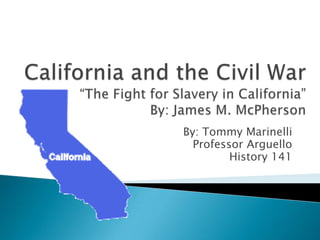
California and the civil war
- 1. California and the Civil War“The Fight for Slavery in California”By: James M. McPherson By: Tommy Marinelli Professor Arguello History 141
- 2. The Fight for Slavery in California In 1845, The annexation of Texas to the US, creating the American Southwest. 1846-1848, The Mexican-American War increased in the size of the US by 1/3 and decreased the size of Mexico by more than 1/2. During the war, Pennsylvania Congressman, David Wilmot, introduced the famous “Proviso” that predetermined any territory conquered from Mexico would be slavery-free. David Wilmot, “Neither slavery nor involuntary servitude shall ever exist in any part of the said territory.” Unanimously, Northern congressman, Democrats, and Whigs supported this Proviso. However, in the South, representatives from both parties unanimously opposed the Proviso. The equal representation of the 15 slave states and 15 free states in the Senate allowed the Southern senators to block Wilmot’s Proviso. David Wilmot
- 3. The Fight for Slavery in California The cotton frontier expanded into eastern Texas in the 1830s. The Natural Limits thesis determined that slavery had reached its “natural limits” and could spread no further into the harsh land of Southwest. Slave states were finally driven into secession when Abraham Lincoln became president in 1860. The territories of Utah and New Mexico legalized slavery in 1852 and 1859. Slaveholding settlers in California made efforts to infiltrate bondage into those states. In the 1850s, California’s representatives and senators voted mainly with the proslavery South.
- 4. The Fight for Slavery in California In 1848, the Treaty of Guadalupe Hidalgo transferred California from Mexico to the United States. Workers building a sawmill near Sacramento discovered flecks of gold in the riverbed of the American River. Rumors spread quickly across the country. By the spring of 1849, tens of thousands of men from all over the US and Mexico, and even Chile, China, Australia, France, and many other countries, traveled to California. By the fall of 1849, the California region had a population as large as Delaware and Florida at the time. With such a large population, California needed institutions of government to maintain law and order. Settlers in California drew up a state constitution in 1849 and petitioned Congress for admission.
- 5. The Fight for Slavery in California The proposed state constitution banned slavery, simply because the 49ers did not want to compete with the slave labor. The admission of California as the 16th free state would inadvertently tip the balance of power. California politics in the 1850s were dominated by the Democratic Party; which was dominated by a coalition of politicians, born in the South, that became known as the “Chivalry.” The Chivalry voted for all of the proslavery measures that were put out by Southern Democrats. The Kansas-Nebraska Act of 1854 repealed the ban on slavery in the Louisiana Purchase. “Filibustering,” a freebooter or pirate, began in California in the 1850s. The first shot of the Civil war was set off in Californiawhen David Terry killed David Broderick in September 1859. The story of California is believed to have intensified the oncoming Civil War of 1861.